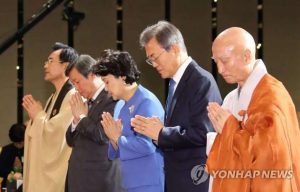In a past article, I suggested a three-point plan that ambitious and gifted Buddhist leaders could consider implementing for an authentic “21st Century Buddhism”. These were: help prospective Buddhists leave behind cultural baggage; pour financial and human resources to involve younger people; and rebuild provincial Buddhist associations. The third proposition has particularly profound implications. While it is easy to understand why attracting younger practitioners will assist demographic sustainability, building grassroots communities means even more than reviving sanghas in an Asian country. Supporting provincial groups also requires communication and collaboration with sanghas in often-overlooked countries like the Russian Federation.
Few would associate Orthodox Russia with Buddhism, but it is the land of the tsars, Soviets, and peerless ballerinas that retained Buddhism as one of the country’s national religions, with footholds in primarily three states: Buryatia, Tuva, and Kalmykia. Kalmykia remains the only Buddhist republic in Europe, with many citizens being descendants of the legendary Golden Horde.
Today, we overlook Buddhism’s integral history in Russia due to Eurocentric assumptions about Russia’s geopolitical orientation. But Russians understand their heritage to be fundamentally cosmopolitan and Eurasian, an inheritance that stretches as far as the Mongol khanates that reached across the entire breadth of the Silk Road. In 1480, Grand Prince Ivan III’s defeated Akhmat Khan’s Golden Horde on the banks of the Ugra River, marking the end of the Mongol-Turks’ rule over the Russian principalities. The long era of Slavic tribute to the Mongols had hung like a shadow over Russia’s national narrative since Batu Khan’s original invasion of Europe in 1236. The presence of Tibetan and shamanic-hybrid Buddhism in Russia would ultimately be a product of not only medieval Russo-Mongolian interaction, but also the conquest of Eurasia during Russia’s imperial period.
Ivan III’s Grand Duchy of Moscow evolved into the Tsardom of Russia (1547–1721), reaching its autocratic zenith in the Russian Empire (1721–1917). In its expansion, the colonial power defeated all the successor khanates to the Golden Horde, and soon Russian colonists were masters of the Eurasian steppes and at the borders of Qing China. It was not surprising that the Qing Empire’s aggression and geopolitics forced the steppe-roaming Kalmyks to Peter the Great’s doorstep in the 17th century. By being allowed to carve out a separate state for their people, these Mongolian nomads became, to this day, members of the Russian polity.
But in the 18th century, Catherine the Great forced the Russian identity upon the Kalmyks, and during the ensuing war they either remained and submitted to the mighty Empress’s demands, or fled and settled along the Tuva and Buryatia regions, which were then under the Qing yoke (indeed, “Kalmyk” is Turkish for “remnants”). The upheaval that characterized the 20th century would not only see post-imperial Russia gain Tuva (Buryatia was already in Russian hands by the 18th century), but also bring great loss and sorrow among the remaining Buddhist, shamanic steppe-people that had not died at the hands of Russians or other Central Asians.
The history of Buddhists under the Soviet Union is a historical phenomenon to be studied on its own terms, but what has survived after the turbulence of the Russian Revolution and the Soviet era is a breathing, living, hardy tradition. For example, Russia still holds the honour of having Europe’s largest Buddhist temple: Kalmykia’s Golden Abode of Buddha Shakyamuni. Meanwhile, Buryatia is proud host to the Ivolginsky datsan, which was opened in 1945 as the only Buddhist centre during the Soviet period. In Buryatia, the word datsan is Tibetan for the Gelug school’s monastic universities in Inner Asia, Tibet, and Siberia, and to this day there are quite a few datsans in Buryatia and Transbaikalia (many of them having reopened after the destruction of all forty-seven between 1927 and 1938).
As Buddhism continues to gradually regain its foothold as one of Russia’s historical and spiritual treasures, we pray that this heritage and spiritual knowledge can reach ever more people around the world. The Buddhism of Russia is quite literally provincial: regional and concentrated, at times isolated or persecuted. No longer: this is their time.













